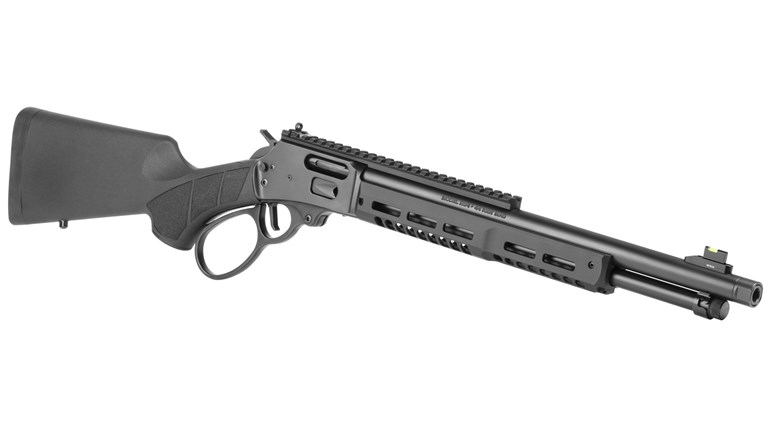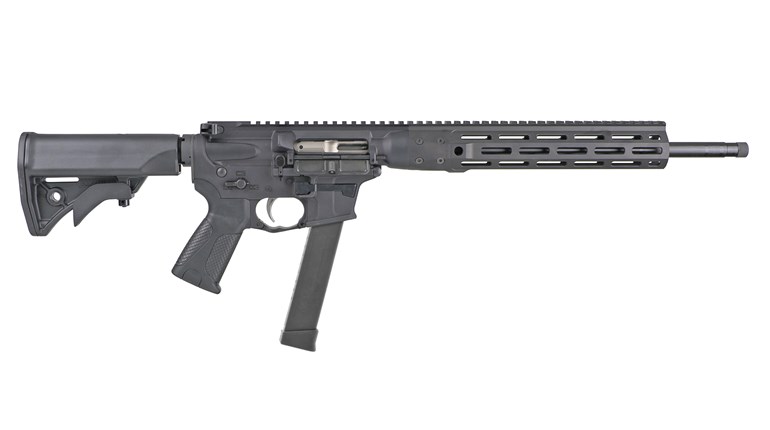
Full disclosure: When it comes to the 7.62x51, we acknowledge we’re on the edge. Not the edge of liking or not liking, but on the edge of full-blown, comprehensive, in-the-tank-for-it adoration.
With a military, law enforcement and sporting pedigree (as the .308 Winchester) as long as the proverbial appendage, what’s not to love? The siring of at least a half-dozen other cartridges, and accolades like “it is probably the most inherently accurate .30 caliber … Few, if any, other cartridges have been so successful in such a wide range of shooting disciplines,” (Sierra Rifle Reloading, 5th Edition) means we step up, jump up, run up any time there’s a 7.62x51 that needs a dance.
All of which means Ruger had us pretty much where they wanted us when their AR-pattern SR-762 showed up.
Teknowbabble
The SR is not dainty, a characteristic it shares with Eugene Stoner’s AR-10—the original AR rifle, which, in a story now well known, eventually became the AR-15/M-16 in 5.56x45 caliber. The SR has some important differences, but not in basic dimensions—it’s a 38-in., 8.6-lb., aluminum upper/lower rifle. Our sample had carbine-style collapsible stock, which gives somewhat better maneuverability, and also accommodates better use with body armor. Still, it’s a lug—a price that’s difficult to avoid, but which also facilitates the use of the more potent cartridge. On the other hand, it makes the rifle a very comfortable shooter for the power.
Hard-coat anodizing and manganese phosphate give the SR a no-nonsense, utilitarian appearance much to our tastes, but we’d still have to note that different materials and/or surfaces have uncommonly uniform coloring. That’s hardly an operational issue, but nicely done all the same: It just makes for a better-looking rifle. (Not that it matters with a rifle you want to get dirty as badly as we did this one.)
Other fit items were all on the plus side with our sample as well: Upper and lower were very snug, and reinforced in all the right places—though not so snug as to make getting inside the rifle a problem. Receiver and handguard rails weren’t quiiiiite a perfect dimensional match, but were well centered enough so that iron sight misalignment issues seemed unlikely to appear. The bolt carrier and bolt are hard-chromed for lubricity, wear life and ease of maintenance.
The trigger assembly proved solid, too. What looked good at the start showed minimal, uniform burnishing after several hundred rounds, with trigger press weight dropping from just over 7 lbs. to a stable, crisp 6.5. The provided handguard didn’t strike us as having much “ooooo-ahhhh” factor, but was comfortably textured and well vented. It proved commendably serviceable in practical respects, too, with tapped mount points along the whole length at 3, 6 and 9 o’clock for rail pieces, and Picatinny available for anything at 12 o’clock. Our Atlas bipod mounted securely to one of the two provided rail sections—with good effect, as you’ll see. A Ruger-marqued Hogue and M4-style 6-position stock completed the furniture.
At The Range
One of our favorite specs on the SR-762 was the “precision-rifled, chrome-lined, cold hammer-forged” barrel. The first, of course, can be claimed from a host of perspectives, and you just have to hope it’s true. If not, a steady hand, clear eye and good ammo will only bring so much to the party. The second and third, however, are objectively true or untrue. But if present, they’re great indicators of hot-barrel performance and overall longevity.
It didn’t take long, either, to sort out what sort of shooter the SR was going to be. Though chrome-lining dictates that traditional barrel break-in may not bear much fruit, we still paced ourselves. Shots one, two and three were taken standing and without much expectation, but nevertheless produced 200-yard gong hits using unremarkable “white box” 147-gr. ammunition. That’s hardly a demanding target for sure, but gratifying given an unfamiliar rifle/trigger and factory-adjusted iron sights.
All subsequent shooting followed suit. The all-metal flip-up BUIS—dual aperture rear and H&K-style hooded front—continued their exemplary performance. In our second range session, this configuration yielded easy upper “A” hits on an MGM B-BC target and repeated three-shot strings of lower “A” zone hits in roughly 3 seconds (2.81 seconds was the fastest) from 100 yards. That’s hardly world-class, but prompt, you might say—a genuine credit to the rail registration and factory sight alignment, as well as a telling commentary on the docile nature of Ruger’s piston implementation. We happened to have a YHM Slant Brake available, and gave it a try on the SR. What's grammatically correct: noticeably "dociler" or "more docile?" Either way, it's a nice add.
With two batches of M118 and several commercial “match” ammo samples on hand, we mounted the splendid Bushnell FFP 6-24x ERS and a precision-oriented shooting session was planned. Not to put too fine a point on it, these efforts were simply overtaken by events. In mediocre conditions (gusting, veering 10-20 mph winds), the SR-762 routinely produced sub-1 MOA groups with everything we fed it, including a relatively rapid-fire 3-shot, (~ 9 seconds, first shot to last see video below) 425-yarder that spanned a tiny .503 MOA. This is fine accuracy by any standard, but we couldn’t resist showing custom gunsmith and rifle-builder Gary Kimball the video. He observed: “That’s incredible … (it) rivals accuracy for a small percentage of custom bolt guns.” In fairness, the Ruger/Bushnell combo made this string easy.
We called it “good” and packed up.
End Game
All through our time with the SR-762, the origins of the whole “AR” series of rifles kept running through our minds. Eugene Stoner had, after all, intended (and prototyped) his design as a 7.62x51, but the Army’s desire for a higher ammunition load-out drove it early to the 5.56x45. In fact, his AR-10 did outperform both the selected rifle—the fine M-14 and the edged-out FN-FAL—just too late in the trials to be selected.
In the SR-762, Ruger has certainly brought all things AR full circle. We’ve grown accustomed to superb Stoner-pattern rifles in 5.56, several of them seen in American Warrior (Adams Arms [piston], and Hodge Defense and Windham Weaponry [direct impingement] to name but a few). But our 7.62 forays have been limited by two factors. First, and as we conceded at the outset, 7.62 rifles draw us with an almost prejudicial allure, but early AR versions were disappointing at best, and therefore had the opposite effect: You might recall magazine and reliability issues, and other tales of woe. Second, the good ones that were available—though fine indeed (the splendid Knight’s SR-25/Mk11/Mk110 comes to mind)—were priced to reflect that excellence. The average guy wanting to shadow a duty arm to build his proficiency had a tall order to fill, cost-wise.
That decisively ends with the Ruger SR-762. Trivial shortcomings—we’d stock it differently, add an ambi charging handle to improve maneuverability around an optic and upgrade the trigger—are merely issues of taste and application.
The discerning rifleman will find the SR a pleasant-shooting, economical, long-lived—and superbly accurate—joy.
































